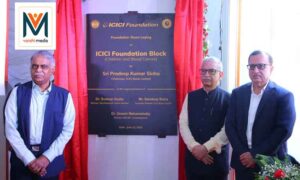United by Family, Divided by Age: HelpAge India Report Calls for Strengthening Intergenerational Bonds
Varahi media.com online news,Hyderabad, June 13, 2025: Ahead of World Elder Abuse Awareness Day (June 15), HelpAge India launched a groundbreaking national study titled ‘Understanding Intergenerational Dynamics & Perceptions on Ageing’ (India Intergenerational Bonds – INBO Report). Following the report’s release, a comprehensive panel discussion involving government officials, community leaders, academics, and media representatives was held at the India International Centre.

Varahi media.com online news,Hyderabad, June 13, 2025: Ahead of World Elder Abuse Awareness Day (June 15), HelpAge India launched a groundbreaking national study titled ‘Understanding Intergenerational Dynamics & Perceptions on Ageing’ (India Intergenerational Bonds – INBO Report). Following the report’s release, a comprehensive panel discussion involving government officials, community leaders, academics, and media representatives was held at the India International Centre.
This first-of-its-kind national study spanned 10 metro and non-metro cities across India (Delhi, Mumbai, Kolkata, Chennai, Bengaluru, Hyderabad, Ahmedabad, Kanpur, Nagpur, and Madurai). It surveyed 5,798 respondents from SEC B and C urban households, with a demographic split of 70% youth (18-30 years) and 30% elders (60 years & above). The study utilized both quantitative data and qualitative Focus Group Discussions (FGDs) to delve into the perceptions, interactions, and emotional dynamics between youth and elders in urban India.
A Call for Deeper Connection Beyond Proximity
Rohit Prasad, CEO, HelpAge India, emphasized the report’s dual message: “This report offers both a heartening affirmation and a timely wake-up call. While respect for elders and family ties remain deeply cherished in India—with 86% of elders feeling valued—beneath the surface lies a quieter, more concerning disconnect. Many elders still feel emotionally distant, unheard, or excluded from meaningful engagement. Expressions like ‘We are told the plan, not asked’ reflect a perception-practice gap that must be addressed.”

He further added, “As India moves forward with its unique demographic advantage—home to the world’s largest youth population and a rapidly growing elder segment—we must build an age-inclusive society that goes beyond the youth or longevity dividend. The real opportunity lies in unlocking the power of ‘intergenerational value.’ Through intentional collaboration across generations—in caregiving, digital literacy, lifelong learning, and volunteering—we can transform ageing from a phase of isolation into one of shared purpose, where generations are bridged not just in proximity, but in vision and co-creation.”
Read This also…Hyderabad records INR 4,000+ cr in property registrations in May 2025, up by 14% YoY: Knight Frank India
As of 2025, approximately 12% of the Indian population is aged 60 and above, a figure projected to rise to 19% by 2050. Simultaneously, India boasts the world’s largest youth population, with over 365 million individuals aged 15–29 years.
Key Findings: Perceptions, Interactions, and Gaps
The report revealed that youth predominantly associate elders with being “lonely” (56%) and “dependent” (48%), yet also “wise” (51%) and “respected” (43%). This indicates a blend of empathy and admiration, alongside the persistence of stereotypical views.
Ms. Anupama Datta, Policy Research & Advocacy, HelpAge India, highlighted further insights: “Young adults, especially those aged 18–24, share strong emotional bonds with their grandparents—particularly in multigenerational households. Interestingly, youth living apart often hold more positive perceptions of ageing, showing that distance doesn’t always mean disconnect.”
She noted that despite lifestyle differences and digital immersion, both generations largely agree on the family’s central role in elder care. Youth acknowledge the generation gap but are willing to bridge it, offering to talk to lonely elders, assist with errands, and support digital inclusion. They also desire educational institutions to help them understand ageing and organize intergenerational activities. Elders, while sometimes feeling undervalued, still wish to spend more time with youth, feel uplifted after meeting them, and prefer living with family. “That’s the complexity to collectively address —by strengthening the positives and consciously addressing the gaps,” she concluded.

Media significantly influences youth perceptions, with 80% acknowledging that portrayals affect their views. Elders are often depicted as wise and caring, but also sometimes as dependent or comical.
Prateep Chakraborty, COO, HelpAge India, affirmed, “HelpAge is advancing an intergenerational approach through its #GenerationsTogether initiative—connecting youth and seniors via digital empowerment, volunteering, and shared learning. Recognizing media’s influence on youth perceptions of ageing, we will collaborate with media, industry, and stakeholders to promote age-positive narratives.”
Report Highlights:
- Regional Variations: Non-metro cities show stronger traditional values and intergenerational bonds, but also greater fears about aging and wider perceived generation gaps.
- Respect Scores: The overall ‘Value and Respect’ score among youth is 63.59 (out of 100), with non-metro youth scoring higher (65.18) than metro counterparts (62.52), indicating deeper respect linked to community-oriented values.
- Key Interactions: Youth primarily interact with grandparents (49%) and parents (45%), while elders connect mainly with sons (50%) and grandsons (40%), underscoring the family’s central role.
- Digital Divide: While 88% of intergenerational communication is face-to-face, a significant digital divide persists: 71% of elders use basic phones, only 41% have smartphones, and just 13% use the internet or social media. Notably, 14% of elders use no digital tools at all.
- Barriers to Digital Adoption: 66% of elders find technology confusing, and 51% fear errors. Youth serve as key enablers (54% of children, 52% of grandchildren act as digital guides), yet youth perceive elders as disinterested (78%) or forgetful (66%), while elders cite youth’s lack of patience (71%) and fast explanations (49%).
- Interaction Barriers: Both groups agree that youths’ busy schedules hinder interaction (elders: 76%, youth: 74%). Youth (25%) feel more judged during interactions than elders (22%). A “generation gap” is acknowledged by both (youth: 51%, elders: 45%).
- Perceived Support Disparities: Elders report high youth assistance with ATM withdrawals (55%) and health insurance (40%), while youth underreport their contributions (23% and 18%, respectively). While 29% of youth claim they offer no financial support, only 6% of elders say they receive none.
- Health Support: Strong mutual support for health: 81% of elders and 82% of youth believe youth should accompany elders to doctors, and 65% from both sides support help with medication and home care.
- Shared Fears for Old Age: Loneliness (youth: 69%, elders: 68%), poor health (67% vs. 61%), and financial insecurity (62% vs. 58%) are common fears. Financial security (elders: 70%, youth: 72%) and good physical and mental health are seen as key to a fulfilling old age.
- Family Living Preference: The desire to live with family remains strong: 88% of youth expect to live with family when old, and 83% of elders currently do or plan to.

Recommendations by HelpAge India:
- Schools-Based Intervention: Implement ‘Age Sensitization’ programs or curriculum in schools to foster empathy and age-respect early on.
- National Intergenerational Engagement Mission: Government should consider establishing such a mission.
- Intergenerational Care: Encourage youth-based community care programs and support for elder care centers with youth volunteers. Corporates should incentivize young employees for such volunteer activities and support informal caregivers.
- Sensitization Awareness Campaigns: Utilize popular media to promote age-positive narratives and raise awareness against ageism.
- Digital Inclusion through Youth-Led Programs: Create opportunities for connection and learning by pairing tech-savvy youth with elders for digital literacy support. Corporates should organize intergenerational training workshops, provide digital devices, and encourage elder-friendly features in apps.




